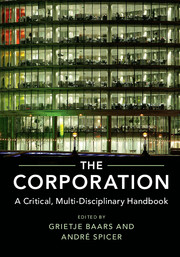Book contents
- Frontmatter
- Contents
- List of Contributors
- Acknowledgements
- Introduction: Why the Corporation?
- PART I DISCIPLINARY OVERVIEWS
- 1 The Corporation in History
- 2 The Corporation in Legal Studies
- 3 The Corporation in Economics
- 4 The Corporation in Sociology
- 5 The Corporation in Anthropology
- 6 The Corporation in Political Science
- 7 The Corporation in Geography
- 8 The Corporation in Accounting
- 9 The Corporation in Management Studies
- PART II INTERDISCIPLINARY THEMATIC CHAPTERS
- 1 The Evolution of the Corporate Form
- 2 The Multinational Corporate Group
- 3 The Financialization of the Corporation
- 4 Corporate Value Chains
- 5 Corporate Citizenship
- 6 The Corporation and Crime
- 7 The Corporation and Ideology
- 8 Corporation and Communities
- 9 Corporations and Resistance
- 10 Alternatives to the Corporation
- Index
- References
4 - The Corporation in Sociology
from PART I - DISCIPLINARY OVERVIEWS
Published online by Cambridge University Press: 31 March 2017
- Frontmatter
- Contents
- List of Contributors
- Acknowledgements
- Introduction: Why the Corporation?
- PART I DISCIPLINARY OVERVIEWS
- 1 The Corporation in History
- 2 The Corporation in Legal Studies
- 3 The Corporation in Economics
- 4 The Corporation in Sociology
- 5 The Corporation in Anthropology
- 6 The Corporation in Political Science
- 7 The Corporation in Geography
- 8 The Corporation in Accounting
- 9 The Corporation in Management Studies
- PART II INTERDISCIPLINARY THEMATIC CHAPTERS
- 1 The Evolution of the Corporate Form
- 2 The Multinational Corporate Group
- 3 The Financialization of the Corporation
- 4 Corporate Value Chains
- 5 Corporate Citizenship
- 6 The Corporation and Crime
- 7 The Corporation and Ideology
- 8 Corporation and Communities
- 9 Corporations and Resistance
- 10 Alternatives to the Corporation
- Index
- References
Summary
Introduction
Corporations have been central institutions in industrialized economies since the turn of the twentieth century. While corporations have existed for centuries as a legal device, and stock exchanges for trading corporate shares emerged during the early seventeenth century, the public corporation as we know it today co-evolved with mass production and distribution around the time of the second industrial revolution. By the start of World War I, public corporations had become a standard way of organizing economic activity in the most advanced industrial economies.
Yet the common term ‘corporation’ masks enormous diversity in corporations around the world. About half the world's economies did not have a domestic stock market in 2012, and those that did varied enormously in how common listed companies are, from Uruguay (6) to India (more than 5000). The number of public corporations was not tightly linked to the size or vibrancy of the economy. Germany, with a vast export-oriented economy, had 665 listed companies; Serbia, with a GDP 1/100th that of Germany, had 1086; while the Netherlands – birthplace of the public corporation – had only 105. Corporations also varied in size and structure: Denmark's largest domestic company had over one-and-a-half million employees (albeit not all in Denmark), while the largest domestic company in Colombia – with ten times the population of Denmark – was only a fraction of that size. Corporations differ in basic aspects of structure required by law, from the protection of minority shareholder rights in different legal systems to whether women or labour must be represented on the board of directors. In short, the term ‘corporation’ is applied to entities that often have little in common.
The sociology of corporations emphasizes that corporations are products of national systems of institutions that vary across cultures and over time. Corporations are often central elements of the economic landscape, with enormous influence on societal outcomes from economic mobility and inequality to public policy. Yet their diversity around the world is under-appreciated in most research traditions, and much work remains to be done.
- Type
- Chapter
- Information
- The CorporationA Critical, Multi-Disciplinary Handbook, pp. 97 - 110Publisher: Cambridge University PressPrint publication year: 2017



